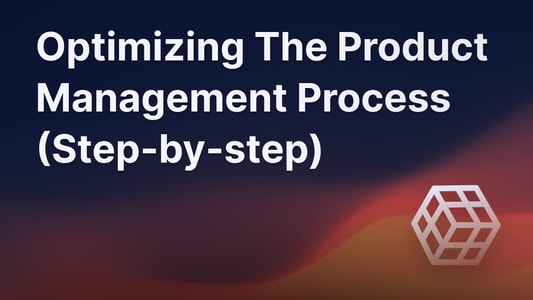Blog RoadmappingA Simple 6-Step Guide to Plan & Prioritize Your Product Roadmap Effectively
A Simple 6-Step Guide to Plan & Prioritize Your Product Roadmap Effectively
Building or prioritizing a product roadmap? Our blog breaks it down into 6 simple steps. Learn to pick the right features and make a plan that is finely balanced between your user's ideas and your own long-term vision.

Prioritizing your roadmap correctly is one of the most important aspects of building a successful startup and your main mission as a product manager.
There are thousands of things to work on, but which ones will actually make a meaningful difference?
Maintaining a balance between your product vision and the overwhelming number of opinions from your customers, who you also want to please, gets increasingly difficult.
In this article, we’ll dive deep into how the best product teams uniquely tackle this problem and provide an easy 6-step guide you can follow to build & present a product roadmap you can be confident in.
The importance of proper roadmap prioritization
You don’t have unlimited time or resources, especially in the early stages of building a startup, so your only option is to use them well.
Product management without a proper system is like navigating a boat with a broken compass.
You and your team put in the effort to row, but without direction, you're just drifting aimlessly in the vast sea.
It creates the illusion of progress, but in reality, you're not moving towards your intended destination.
Here are common examples of what not to do:
- Not listening to user feedback - a lot of us tend to think we're the next Steve Jobs and assume we know what's best for our users without any actual evidence. This, more often than not, leads to a product no one wants. Use a simple feedback tool like Featurebase to collect ideas and feature requests from your customers.
- Blindly following user feedback - while customer input is very important, it should not be followed blindly. Feedback from a vocal minority might entirely derail your roadmap, aligning it more with niche demands rather than the broader user base.
- Copying competitors - just because a competitor built something doesn't mean it's right for you, nor does it mean they know what they are doing.
- Following hype cycles - e.g. building useless AI or Web3 features just because everyone is saying that it's the next big thing.
- Building whatever is easy or fun - prioritizing tasks based on ease or enjoyment might feel productive, but it can sidetrack you from tackling challenges that are crucial for business advancement.
It sounds obvious when laying it out like this, but a surprisingly large percentage of startups operate this way.
Now that you know the importance of having a proper system in place, let's dive into a step-by-step guide of how you should build and prioritize your product roadmap the *right* way.
6 Step guide for creating a successful product roadmap
1. Define your own product goals & review your backlog

Start by establishing fundamental goals for your product.
These goals will guide your roadmap and align it with your long-term strategy.
Examples of Goals:
- Enterprise Viability: Target features that make your product attractive to large companies, like enhanced security or scalability.
- Reduce Churn: Set a goal to decrease customer churn, focusing on improving user satisfaction and loyalty.
- Improve Onboarding: Aim to increase the completion rate of your onboarding process, enhancing early user engagement.
Review Your Product Backlog
Examine your existing backlog for ideas that support these long-term goals.
You’ll likely uncover valuable features or improvements that align with your strategic objectives but haven't been prioritized yet.
2. Go through your product feedback

As a product manager or a founder, you should have a crystal-clear understanding of who your customers are and what they want.
To get a comprehensive overview, let's dive into 3 types of customer feedback:
Feedback from your power users
- Analyze Feedback, Feature Requests & Bug Reports: Analyze all types of feedback from your power users, whether it's from emails, public forums, live chats, surveys, or social media. Power users often provide the most insightful feedback because they have run into all kinds of issues or smaller papercuts by using them all the time.
- Analyze Usage Patterns: Look at how these users interact with your product. What features do they use the most? Understanding their behavior can guide you in prioritizing the most important parts of your product to double down on. Pro tip: Use a tool like Posthog to easily analyze user journeys to identify even more potential opportunities for improvements.
- Engage Directly: Consider reaching out to some of your most engaged users. Their detailed input can be invaluable in refining and prioritizing new features. Bonus: As a founder, you can kill two birds with one stone by also using these chats to build case studies.
Understand why customers left you
- Understand the Reasons for Churn: Analyze exit surveys or conduct follow-up interviews to understand why these customers left. Was it a missing feature, pricing issues, or something else? Tip: You can use a tool like ChurnKey to measure that or incentivize interviews with some gift cards.
- Identify Patterns: Look for common themes in the feedback from churned customers. This can highlight critical areas for improvement or development in your product.
Find out what is holding back potential customers
- Monitor Competitors: Understand what competitors offer and how it might be attracting your potential customers. This can reveal gaps in your own product or opportunities for differentiation.
- Evaluate Marketing Messages: Sometimes, it’s not the product but the messaging. Ensure that your marketing accurately reflects your product’s value proposition and addresses the needs of your potential customers.
By systematically gathering and analyzing feedback from these three groups, you can gain a full understanding of your product's strengths and areas for improvement, helping you make better product decisions in the prioritization process.
3. Combine a list of ideas & features: The 50/50 Approach

Now that you have a good understanding of your product vision and what your customers want, it's time to blend these insights into a viable strategy.
When it comes to balancing your product vision with customer input, a practical approach is the 50/50 rule.
Allocate half of your focus to your own innovative ideas that align with long-term goals, and dedicate the other half to addressing what feature ideas your users explicitly want.
This method ensures a balanced roadmap that is both visionary and responsive to user needs.
- Integrating Your Vision: Start by selecting ideas from your backlog that strongly align with your product’s long-term objectives. These should be potential features or improvements that progress your vision set your product apart.
- Incorporating User Feedback: Then, equally prioritize ideas that come directly from user feedback. These are often focused on current usability, addressing pain points, or adding requested features.
- Creating a Balanced Roadmap: Merge these two sets of ideas to create a roadmap that is both forward-thinking and grounded in making your users happy. This helps in maintaining innovation while also ensuring that the product remains user-centric.
Integration of your vision and customers' input ensures that your roadmap is not only visionary but also grounded in real user needs. That way, you set the stage for a product that resonates with your audience and stands out in the market.
4. Pick a prioritization framework

With a list of ideas that align with your vision and user feedback, it's time to figure out what's most important.
Common strategies:
- Value vs. Effort Matrix (aka Value Complexity Matrix): This method involves looking at how much value each feature will add for users and how hard it is to build. For example, a simple feature that users will love is a top priority. On the other hand, a feature that’s great but really hard to make might need more thought.
Formula: Value to Users / Development Effort Score. - MoSCoW Method: Here, you sort features into 'Must have', 'Should have', 'Could have', and 'Won’t have' groups. For a shopping app, a safe way to pay is a 'Must have'. A nice extra, like being able to see product recommendations, is a 'Should have'. Features that are nice but not essential, like linking to social media, are 'Could have'.
Formula: Categorize features into Must-Have, Should-Have, Could-Have, and Won't-Have. - Kano Model: This approach looks at how different features will make your users happy compared to the effort required. Basic things like signing in are expected and don’t add extra happiness, but they’re necessary. Meanwhile, a feature like customizing the app to each user could really make users happy and stand out, even if it’s not as hard to build.
Formula: Classify features based on User Satisfaction vs. Implementation Effort. - RICE Framework (or RICE Score): This involves scoring features based on four factors: Reach, Impact, Confidence, and Effort. For instance, adding a new payment option might 'Reach' many users, have a high 'Impact' on sales, you might be 'Confident' it will work well, but it could be high in 'Effort' to implement.
Formula: Reach x Impact x Confidence / Effort. - ICE Method: This method evaluates features based on the impact they will have on your goals, your confidence in this impact, and the ease (or effort) of implementation. It's particularly useful for startups and agile environments where quick decision-making is essential.
Formula: Impact x Confidence x Ease.
Each of these strategies helps you see your product features in a slightly different way.
Value vs. Effort is great for quick, impactful decisions. MoSCoW for managing limited resources or tight deadlines. Kano for enhancing user satisfaction. RICE framework for a comprehensive evaluation of impact and feasibility. ICE for a nimble, impact-focused approach.
The choice of a method should align with your product's specific goals, market position, and the nature of your user base.
5. Create your roadmap

Now that you have figured out what ideas are worth including, it's time to plug them into a visual product roadmapping tool.
If you're a modern company and don't want to deal with old and complex software, then check out Linear to create your product roadmap.
It supports tons of features for what product teams expect e.g. list, board, and timeline views, and isn't cluttered with unnecessary complexities like some other options.
Make sure to involve your whole team in this process to come up with realistic timelines and add priorities to when you are going to ship something.
Make your roadmap public
A great way to verify that your product roadmap hits the mark is to ongoingly gather feedback for it.
With Linear and other similar tools, you can effortlessly plug in a tool like Featurebase to help you do that automatically.
It's an amazing way to communicate progress with your users and key stakeholders to keep everyone up-to-date about what you're working on.
It also makes it super easy to capture feedback for all your ideas to make sure you're building solutions aligned with genuine needs.
Bonus: Check out public roadmaps of larger companies for inspiration. Here are some of the best examples →
Other options
If you feel like Linear isn't a good fit for you for some reason, then some other options are Roadmunk, Productboard, or Jira.
Keep in mind that even when using a tool, some product teams still prefer having the high-level goals written down on some sticky notes to always be reminded of what's important. :)
6. Adjust and communicate progress

A product roadmap is never set in stone.
Regular reviews and changes are needed to ensure it remains relevant.
- Schedule Regular Reviews: Set a regular schedule for reviewing the roadmap. This could be monthly, quarterly, or as needed based on the project’s pace.
- Gather Feedback: Continuously collect feedback from users, team members, and stakeholders. This feedback is invaluable for making informed adjustments.
- Monitor Progress: Keep an eye on the development progress. If certain features are taking longer than expected, reprioritize if needed.
- Communicate Changes: Any changes to the roadmap should be clearly communicated to all stakeholders to ensure alignment and understanding.
Communicate Progress
Whenever you complete a major milestone in your product roadmap, consider publishing a changelog about it.
It's an easy way to celebrate wins, communicate progress, and boost customer satisfaction.
It makes sure all stakeholders, employees, and users know that your company is making progress.

I highly recommend reading a blog post from Karri Saarinen (co-founder of Linear) about this topic.
If you're looking for a simple tool to publish changelogs, check out Featurebase to publish your first one in just a few minutes. It's also the one featured in the illustration. ☝️
Summing it up

Prioritizing your roadmap correctly is the most important aspect for product teams.
You can use our simple 6-step guide to plan & prioritize a professional product roadmap:
- Define your goals
- Analyze user feedback
- Create a list of ideas using 'The 50/50 Method'
- Prioritize (with a framework)
- Create the roadmap itself
- Update regularly and share
Remember, the key is to stay flexible, continually gather feedback, and adapt your roadmap as needed. You can use special tools like Featurebase and Linear to help you on the way.
By following these steps, you can build a product roadmap that aligns with both your strategic goals and your customers' needs.
More reading:
- Top 7 Public Roadmap Tools for SaaS Companies in 2024 →
- Should Your Company Have a Public Roadmap? →
- 12 Public Roadmap Examples for SaaS Companies in 2024 →
- The Best Product Roadmap Examples for SaaS Startups →
FAQ Section
What is product roadmap prioritization?
Product roadmap prioritization is the process of deciding what features or improvements to focus on in a product development cycle, based on factors like business goals, user needs, and resource availability.
Which prioritization technique is best for small businesses or startups?
The Value vs. Effort Method is often suitable for startups due to its focus on impact and ease, allowing for agile and quick decision-making.
How do you prioritize a product roadmap?
To effectively prioritize a product roadmap, you can use our simple 6-step guide:
- Define your goals
- Analyze user feedback
- Create a list of ideas using 'The 50/50 Method'
- Prioritize (with a framework)
- Create the roadmap itself
- Update regularly and share
What are some common product prioritization techniques?
Popular techniques include the Value vs. Effort Matrix, MoSCoW Method, Kano Model, RICE Framework, and ICE Method. Each has its own unique approach to evaluating and ranking features and best use cases.
How can product ideas be transformed into a prioritized roadmap?
Begin by aligning ideas with your product goals and user feedback. Use a prioritization framework to evaluate and rank these ideas based on their impact, feasibility, and alignment with your goals, then organize them into a structured, visual roadmap.
Why is prioritizing a product roadmap important?
Prioritizing helps ensure that the most impactful feature requests and ideas are developed first, maximizing resource efficiency and meeting user needs effectively.
The simple feedback tool with feature voting for your customer feedback. Built-in the 🇪🇺.
© 2024 Featurebase. All rights reserved.



